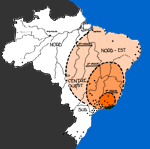Migration Caused by Rural Exodus
The urban structure of today's Brazil was dictated by colonizers' politics.
Their only interest in overseas trading ended at the coast by creating harbour cities.
In the beginning of the 20th century Rio had become Brazil’s industrial
centre and its first city to suffer from migration.
According to Drummond there are four waves of migration:
 The first wave, caused mainly by attractive salaries in the city, attracted rural population
from Guanabara, whose descendants make up 50 percent of today’s favelas. The rural exodus was
so intense that Rio's population doubled from 1930 within 5 years to 2.38 million.
The first wave, caused mainly by attractive salaries in the city, attracted rural population
from Guanabara, whose descendants make up 50 percent of today’s favelas. The rural exodus was
so intense that Rio's population doubled from 1930 within 5 years to 2.38 million.
In 1940, the second wave arrived from neighbouring states Espirito-Santo
and Minas-Gerais. In 1960, the road from Salvador de Bahia to Rio de Janeiro
was built, a call to the south, the land of industries and workplaces. Consequently
the way to Rio has gotten easier and faster so that not only the coastal but also the
western population (tormented by drought) followed the call, forming the third wave.
43 percent of industries are located in the states of Rio de Janeiro, Minas-Gerais and Espirito-Santo.
These three waves are typical for rural exodus, since the rural population has no possession.
Two percent of the population possess 60 percent of Brazilian land.

The rural population is dependent on large landed proprietors, who are recruiting farm
labourers on an as-needed basis and only for room and board. This makes it impossible for
them to emancipate themselves, except by emigration to the city. This is especially true when
prospects for work are next to nothing during periods of drought.
In the city 64,7% of labourers are earning more than minimum wage; in the countryside, only 14,9 %.The image of the heavenly south has been created by industrial magnates and by rural migrants to the city themselves.
Rural migrants sent letters with superfluous photos of nice girls, sporty cars, and other ingredients of the urban world of consumption, which – of course – were not available to them. Letters illustrated the Arcadia 'city,' a distortion substantiated in black and white by the media.
The rate of population growth among rural migrants was a totally unexpected fact. It was so high that Drummond defined it as the fourth wave of migration.
This excessive growth rate was never noticed until now, since the infant mortality rate in the countryside was a lot higher than in the city.
These four waves had been observed; but no reactions were observed. So Rio's population grew and grew. Even today the problem has yet to be resolved.
Favela
These are highly consolidated residential self-construction on
invaded public and private land and without infrastructure. These
exist in large numbers all over Rio.
UN habitat
Ensemble von gemeinen Wohnungen unfachmännisch gebaut (in der Regel auf Hügeln) und hygienisch unversorgt.
novo dicionairo de lingua portuguesa
Favela ist ein unübersetzbares brasilianisches Wort. Man
könnte es einfach als Synonym für Armut und Elend
setzen, aber ein brasilianisches Wörterbuch der
portugiesischen Sprache definiert es folgendermaßen:
Bezeichnung eines Hügels in Rio de Janeiro, Zuflucht der
Armut, der Gaunerei, des Nichtstuns und des Streites, eine Art
„Cour de Miracles“ von Paris. Es bedeutet ein Gebiet
des sozialen Verfalls, der fehlenden Anpassung und der
Zersplitterung.
1987 Vorwort von Audálio Dantas zu Carolina
Maria de Jesus Tagebuch der Armut
Didier Drummond Architectes des favelas, Bordas, Paris 1981